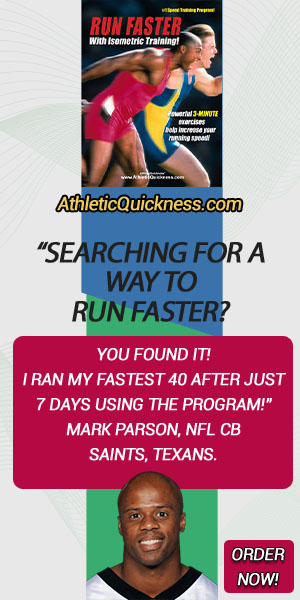
HIP EXTENSOR MUSCLES: GLUTES AND HAMS
If you’re an athlete who is always slow to react to the ball or get into good defensive position, then you are probably lacking the necessary strength in your hip extensor muscles for a quick first step.
The Hip Extensor muscles are located in the buttocks region of the body and posterior thigh. There are four primary muscles in this region and their names are the Gluteus Maximus, Semimembranosus, Semitendinosus and Biceps Femoris Long Head. The short head of the Biceps Femoris does not cross the hip joint and is therefore not a hip extensor. See Figure 1.

The Gluteus Maximus is perhaps the most popular muscle in this group. This is due in part to its large square-shaped size and the fact that it is the strongest of all the extensors. Being also the most superficial muscle in the buttocks region, it gives the human body a characteristic shape.
It begins just below the iliac crest and attaches near the greater trochanter of the femur. Since it crosses the hip joint directly (the hip joint is a ‘ball and socket joint’ where the ‘ball’ is the head of the femur that inserts into the ‘socket’, which is the acetabulum formed by the ilium, ischium and pubis bones) it is capable of producing a very strong action of the femur on it.
The other three muscles, while collectively known as the hamstrings, is perhaps not entirely accurate as they relate to hip extension. This is because the hamstrings also include the short head of the Biceps Femoris, but as we stated earlier, the short head doesn’t cross the hip joint and therefore produces no action on it.
As long as you are aware of this, it is common to still refer to them as such and it will be assumed that the reader is aware of this fact throughout the remainder of this article.
The long head of the Biceps Femoris begins at the tuberosity of the ischium, which is also the originating point for the Semitendinosus muscle. The long head extends down past the knee joint and unites with the short head to insert into the lateral side of the fibular head. Since the long head crosses two joints, the hip and the knee, it will produce action on both which are hip extension and knee flexion.
The short head of the Biceps Femoris originates on the middle third of the posterior femur, and so it is nowhere near the hip joint being that it originates so much lower than it. Therefore, this is the reason it is excluded as an extensor of the hip.
The Semitendinosus is known for its long rounded tendon and is clearly visible in Figure 1 above. The muscle belly itself terminates a little more than half way down the medial side of the back of the thigh. The tendon crosses the knee joint and inserts into the posterior, upper and medial region of the tibia. Like the long head of the Biceps Femoris, it crosses two joints and therefore produces actions on both, that being, hip extension and knee flexion.
The Semimembranosus originates at the superior and lateral aspect of the ischium just to the outside of where the long head of the Biceps Femoris and Semitendinosus originate. It inserts into the posterior superior tibia. Like the other two hamstring muscles, it crosses the hip and the knee producing similar actions on them.
Since the hamstrings have two functions, hip extension and knee flexion, we will save our discussion regarding knee flexion for another article.
The remainder of this one will focus only on their role as hip extensors.
The hip extensors are a powerful group of muscles. One of their main functions is to raise you up from a crouched position as seen in Figures 2a and 2b.

These muscles are actively engaged in most of the exercises where a pushing motion, or force, occurs such as front squats, back squats, power cleans (with respect to the legs only), clean/pulls (again, with respect to the legs only) and box jumps to name a few.
Pushing and Pulling Forces
Pushing forces are forces that cause motion away from the source of the force. In the examples above, you are supplying force against the ground through your leg muscles (hip extensors and knee extensors) in order to move away from it. In other words, you are pushing upward and away with your legs.
Pulling forces are forces that cause motion toward the source of the force. An obvious example of a pulling-type of exercise for your legs would be the leg/knee curl. Here, you are directing force created in your hamstrings through the back of your legs into a padded bar carrying weight toward your buttocks. In other words, you are causing motion in the form of your legs moving toward the source, your hamstrings, so by definition, you are pulling the weight close to you.
As they pertain to running, the hip extensor muscles are involved in both pushing and pulling you forward during the motion but many are not aware of this fact and instead only see the hip extensors as great pushers in the running motion, not pullers.
But in the article on the Running Motion, we learned that the hip extensors both push and pull. And in order to determine what type of force your leg was providing, a reference point needed to be established since the majority of this running motion was taking place in the horizontal plane.
It was there that we determined that when your thigh was perpendicular to the ground that this was the dividing point between the muscles that push and the ones that pull. See Figure 3.

It was then pointed out that whenever your foot was on the ground and your thigh was behind this reference line of the hip, (i.e., the thigh was no longer perpendicular to the ground), your hip extensor muscles (as well as the knee extensors and ankle plantar-flexors) were pushing you forward. See Figure 4.

This fits the definition of a pushing force where motion is created away from the source of the force. The source of the force is the combined effect of muscles in your hip (hip/thigh extensors), knee (knee/leg extensors) and ankle (plantar-flexors) acting through the foot touching the ground.
Through contractions in these three muscle groups the runner’s body is moved away from it as observed by the direction of the arrow in Figure 4 above.
It was also pointed out that whenever your foot was on the ground and your thigh was in front of the reference line for the hip, your hip extensor muscles would pull you forward as you ran. See Figure 5.
The way this occurs is as follows: first, recall what was mentioned earlier that a pulling force is a force that causes motion toward the source of the force. The source of the force in this case is the stretched hip extensor muscles (mainly the Gluteus Maximus) located in the back of the buttocks.
With the origin of this muscle in the back and its insertion around the side and toward the front near the greater trochanter of femur, the motion it creates by contracting is to draw the length of the entire femur (thigh) toward it, or underneath the runner’s hip and body.
We can see the progression of this movement taking place by following the position of the right thigh (yellow arrow) in Figures 6a, 6b and 6c below. Here, the thigh is being drawn underneath the runner’s body until finally it reaches a neutral or perpendicular position, where there is neither flexion or extension of the thigh at the hip joint in Figure 6d.
Since this force (Gluteus Maximus) causes motion (the runner’s thigh) to move toward it, it is by definition a pulling-type force.

As an athlete who is concerned about your running speed, it would be of great benefit to you to balance the number of pushing and pulling exercises you do involving your hip extensor muscles.
A list of the pushing-type exercises was previously mentioned. A traditional pulling-type of exercise involving your hip extensors would be walking lunges where the pull comes from the motion created by the leg on the ground in front of you as it draws you forward while preparing to take the next step. This is similar to the movement in the progression of images above from Figure 6a through 6d.
Aside from this example, there are some extraordinary ones that you can do involving resistance bands using an isometric training strategy. These exercises can really help isolate and ‘pin these muscles down’ in a very safe manner that allows you to exercise peak contraction force in them very quickly.
The Run Faster Speed Training Program focuses on several of these types of exercises for your hip extensors as well as other muscles involved in running and athletes all over the world have achieved great success increasing their running speed using them.



